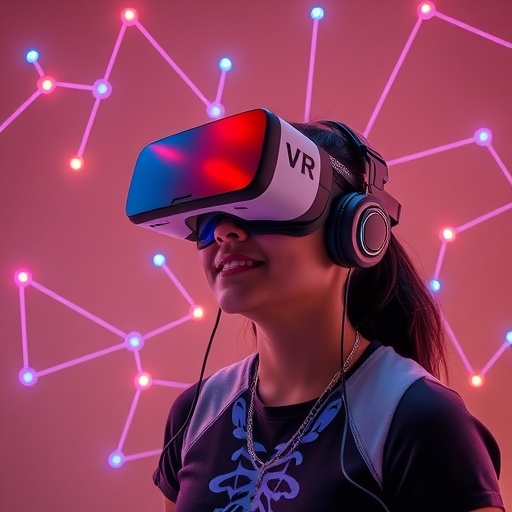In an era where immersive technologies are reshaping how we engage with scientific concepts, a groundbreaking extended reality (XR) experience titled “MuMu: Worlds of Connection Chapter One” has emerged from the University of Nebraska–Lincoln, weaving complex network science into an interactive and tangible exploration of a futuristic apple farm ecosystem. This project transcends traditional educational approaches, enabling players to inhabit the roles of multiple entities—ranging from an apple tree to a robot tractor—thus offering an unparalleled multispecies perspective on the intricate web of life and technology that sustains agricultural environments.
At its core, MuMu—an acronym for Multispecies Multiplex—serves as a vivid digital laboratory where users explore the myriad connections vital to ecosystem health, emphasizing the symbiotic relationships between humans, animals, plants, and technology. Developed over five years with substantial support from a $1.2 million Science Education Partnership Award (SEPA) granted by the National Institutes of Health, this experience stands out for its innovative synthesis of interdisciplinary expertise spanning sociology, biology, engineering, and digital arts.
This XR platform intentionally shifts the learning paradigm away from passive observation to embodied interaction. Players fluidly transition among different perspectives, literally stepping into lives as varied as root systems underground, tunneling prairie dogs, and sophisticated robotic farm machinery. This role-shifting mechanic is critical for revealing the often-invisible networks that define ecosystem dynamics and health—a challenge that traditional textbooks and lectures struggle to address effectively.
MuMu’s conceptual foundation draws from multispecies health studies and multispecies design principles, which frame human health as inseparable from environmental and biological networks. The experience candidly illustrates how each species on the farm contributes to a viable and balanced ecosystem. For instance, prairie dogs play a crucial role by aerating the soil, thereby fostering robust plant growth that ultimately supports nutritional food production and human well-being. These insights align tightly with research from fields such as veterinary epidemiology, biological systems engineering, and network science, ensuring that the experience is not only artistically immersive but scientifically robust as well.
The development team was notably collaborative and multidisciplinary. Key contributors included Julia McQuillan, a sociology professor specializing in network science; Elizabeth VanWormer, a veterinary epidemiologist overseeing One Health initiatives; Santosh Pitla, an engineer focused on agricultural robotics; and Bilal Khan, a mathematician with expertise in computer network modeling. This collaborative synergy exemplified in MuMu highlights how modern scientific challenges demand cross-cutting research and creative technological solutions.
One hallmark of MuMu is its sophisticated spatial sound design, engineered by English professor Stephen Ramsay. The audio dynamically responds to player movement, immersing users within a three-dimensional soundscape that reinforces the illusion of presence within the digital ecosystem. Coupled with detailed animation and interaction crafted by emerging media artists of the Johnny Carson Center for Emerging Media Arts, this results in a sensory-rich environment that deeply engages cognitive and sensory faculties, enhancing the absorption of complex scientific principles.
Importantly, MuMu’s educational design targets middle school-aged audiences, a demographic often underserved by complex scientific outreach but ripe for cognitive engagement with network concepts foundational to public health and environmental sustainability. The game leverages the metaphor of a high-tech apple farm set ten years in the future to frame these ideas in an accessible yet forward-looking narrative. Through this metaphor, players intuitively grasp how interconnectedness within ecosystems directly shapes health outcomes across multiple species.
Throughout its development, MuMu underwent rigorous play-testing with diverse youth groups, including participants from local STEM clubs, specialized educational programs, and Indigenous youth research initiatives. Observers consistently noted moments where players experienced an “aha” realization—a sudden comprehension of the ecosystem’s interdependence that fundamentally shifted their perspective. This pedagogical breakthrough signifies the power of XR to serve as a cognitive bridge, translating abstract sociological and ecological theory into experiential, embodied understanding.
With its underlying grant support concluded, stewardship of MuMu has transitioned to Edgeworks, a design and research bureau within the Carson Center. This institutional integration ensures ongoing maintenance, refinement, and expanded outreach, positioning the experience not as a static product but an evolving platform capable of independent growth and collaboration with a broader scientific community. The project’s digital presence is further connected through the Worlds of Connections webpage hosted by the University of Nebraska–Lincoln’s Center for Math, Science and Computer Education, providing additional educational materials and engagement opportunities.
MuMu’s thematic emphasis on network science is particularly prescient given its ties to pressing public health concerns such as opioid addiction, studied through the university’s Rural Drug Addiction Research Center. By illuminating how human social networks intersect with ecological and technological networks, the experience bridges abstract scientific research with tangible community challenges, demonstrating the broader applicability of network science beyond purely academic circles.
As the boundaries between the digital and physical worlds continue to blur, MuMu exemplifies how extended reality can be a vital tool for scientific education—one that respects the complexity of real-world systems while rendering them accessible and compelling. By inviting players into a multispecies ecosystem where every action reverberates across human, animal, plant, and technological networks, the experience fosters a sense of shared stewardship and holistic health crucial to addressing 21st-century planetary challenges.
For science communicators, educators, and technologists, MuMu represents the vanguard of immersive, network-informed pedagogy. It is a timely reminder that the future of science education lies in crafting experiences that do not just convey information but cultivate new ways of perceiving the interconnected world around us. As the Meta Horizon Store offers free access to the game, this innovative platform holds vast potential to inspire curiosity, empathy, and scientific literacy across generations.
Subject of Research: Network Science, Multispecies Health, Extended Reality in Science Education
Article Title: MuMu: An Immersive Extended Reality Journey Through Multispecies Ecological Networks
News Publication Date: Information not provided
Web References:
- MuMu on Meta Horizon Store: https://www.meta.com/experiences/mumu-worlds-of-connections/8314248428678273/
- Worlds of Connections webpage: https://cms.unl.edu/cas/sociology/worlds-of-connections/
References: Not specified in text
Image Credits: MuMu: Worlds of Connection
Keywords: Extended Reality, Network Science, Multispecies Multiplex, Ecosystem Health, Public Health, Science Education, XR, Multispecies Health, Interactive Learning, Immersive Technologies, Digital Ecology, University of Nebraska–Lincoln




